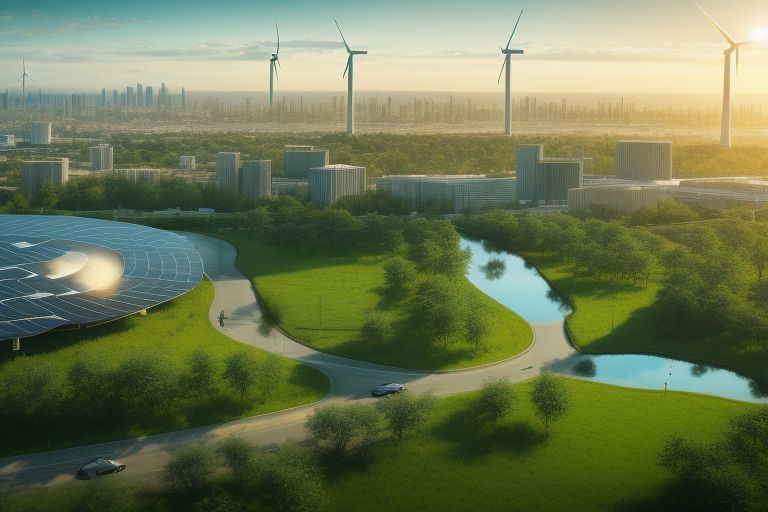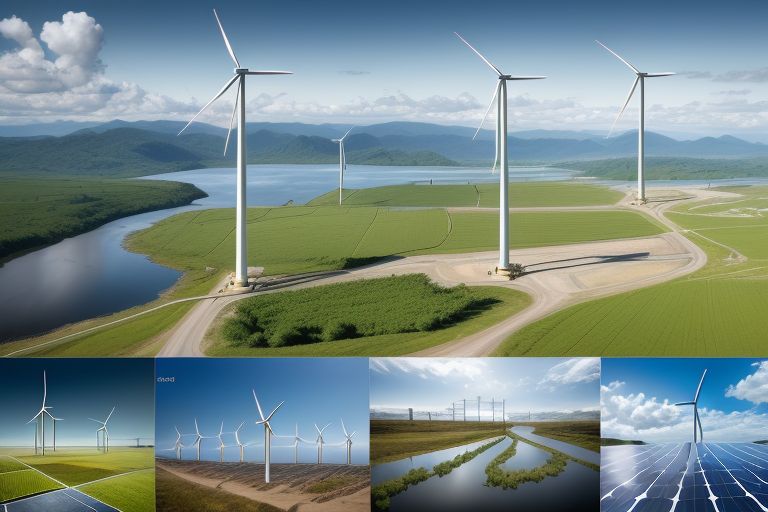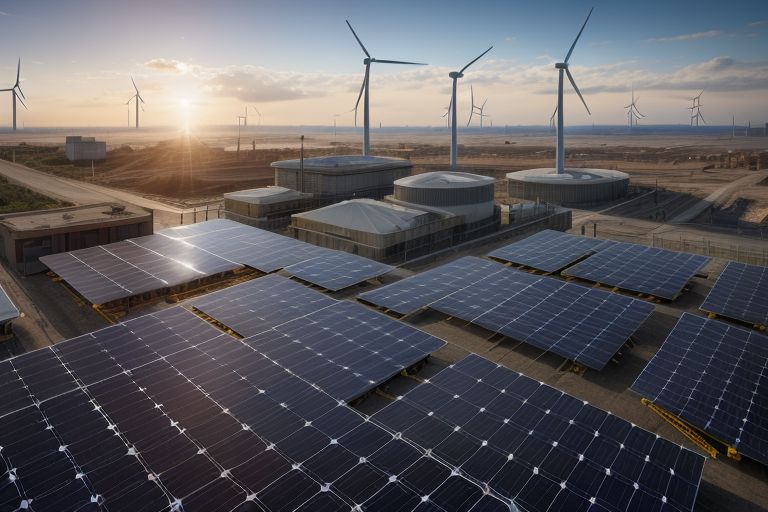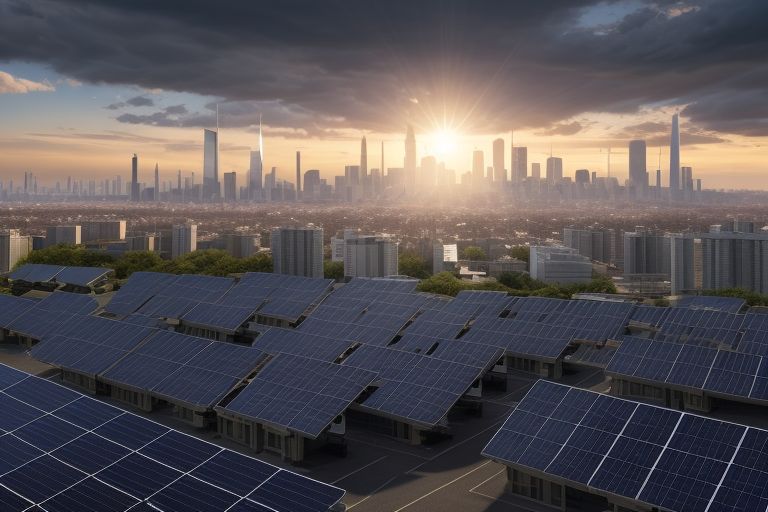- [email protected]
- +254 723 065019
- Mon - Sat 9:00 AM - 5:00 PM
- Login or Register
- Favorites
8.1 Introduction to Renewable Energy Sources
Lesson 8.1: Introduction to Renewable Energy Sources
Welcome to Lesson 8.1: Introduction to Renewable Energy Sources. As the world increasingly focuses on sustainability and reducing our environmental footprint, renewable energy sources have become a crucial component of this transition. In this lesson, we will explore the various types of renewable energy, their advantages, and their role in creating a more sustainable energy future.
Renewable energy sources, such as solar, wind, and hydro power, offer an alternative to conventional fossil fuels, which are finite and contribute to environmental degradation. Understanding these energy sources is essential for making informed decisions about energy use, policy-making, and sustainable development.
Throughout this lesson, you will gain insights into the fundamental concepts of renewable energy, including how these sources work, their benefits, and their impact on reducing greenhouse gas emissions and reliance on non-renewable resources. This knowledge will lay the foundation for understanding how renewable energy can be integrated into various applications, from residential buildings to large-scale power generation.
Let’s embark on this journey to discover how renewable energy sources can contribute to a cleaner, greener, and more sustainable world.
Objective:
By the end of this lesson, learners will gain a foundational understanding of various renewable energy sources. They will explore the different types of renewable energy, including solar, wind, hydro, geothermal, and biomass, and understand their unique benefits and applications. This lesson aims to equip learners with the knowledge to identify how these energy sources can be integrated into construction projects and other sectors, enhancing sustainability and reducing environmental impact. Key learning outcomes include:
- Recognizing the types of renewable energy sources and how they work.
- Understanding the environmental and economic benefits of using renewable energy.
- Exploring practical applications and integration strategies for renewable energy in construction and other fields.
- Evaluating the role of renewable energy in reducing reliance on fossil fuels and contributing to a sustainable future.
1. Definition and Importance of Renewable Energy
In this section, we will delve into the concept of renewable energy, which plays a pivotal role in shaping a sustainable future. Renewable energy refers to power derived from natural sources that are replenished on a human timescale, such as sunlight, wind, and geothermal heat. Unlike fossil fuels, which are finite and contribute to environmental degradation, renewable energy sources offer a cleaner and more sustainable alternative.
Understanding the definition and importance of renewable energy is crucial for several reasons. First, it helps us recognize the environmental benefits, such as reduced greenhouse gas emissions and lower pollution levels. Second, it highlights the economic advantages, including job creation and energy security. Lastly, it underscores the role of renewable energy in mitigating climate change and achieving energy independence.
By exploring these aspects, we will establish a solid foundation for appreciating how renewable energy can transform industries, including construction, by integrating cleaner, more efficient energy solutions into various projects and practices.
Key Points:
a. Definition
Renewable energy refers to energy sourced from natural resources that are continually replenished on a human timescale. These resources include sunlight, wind, geothermal heat, and water. Unlike fossil fuels, which are finite and require millions of years to form, renewable resources are abundant and regenerate naturally. This continual replenishment makes renewable energy a sustainable and reliable alternative to traditional energy sources, helping to meet current energy demands while minimizing environmental impact.
b. Characteristics:
- Abundance: Renewable energy sources are widely available across the globe and are not subject to depletion within a human lifetime. Resources like sunlight, wind, and geothermal heat are naturally replenished, making them a sustainable option for long-term energy generation.
- Lower Environmental Impact: Unlike fossil fuels, renewable energy sources produce minimal greenhouse gases and other pollutants, leading to cleaner air and water. This significantly reduces the carbon footprint and mitigates environmental issues such as climate change, acid rain, and water pollution, contributing to a healthier and more sustainable planet.
c. Importance
- Renewable energy is essential for addressing several critical global challenges. It plays a key role in reducing greenhouse gas emissions, which are the primary drivers of climate change. By transitioning to renewable sources, we can significantly lower our carbon footprint, mitigating the adverse effects of global warming and extreme weather events.
- Reduction of Dependence on Finite Fossil Fuels: Renewable energy helps decrease reliance on finite fossil fuels, which are not only environmentally damaging but also subject to market volatility and geopolitical instability. This transition promotes energy independence, enhancing national security and reducing exposure to fuel price fluctuations.
- Promotes Sustainable Development: Investing in renewable energy supports sustainable development by fostering technological innovation, creating green jobs, and driving economic growth while protecting natural ecosystems for future generations.
d. Benefits:
- Improved Air Quality: Renewable energy sources produce little to no air pollutants compared to fossil fuels, which release harmful emissions like sulfur dioxide, nitrogen oxides, and particulate matter. This reduction in pollution leads to cleaner air, which is crucial for public health, reducing respiratory illnesses, and enhancing overall quality of life in communities.
- Energy Security: By diversifying energy sources and relying on locally available renewable resources like solar, wind, and geothermal, countries can reduce their dependence on imported fossil fuels. This diversification enhances energy security, making energy supply more resilient to global market fluctuations, geopolitical tensions, and supply chain disruptions.
- Sustainable Development: Renewable energy plays a critical role in sustainable development by supporting long-term economic growth without depleting natural resources. It fosters innovation in green technologies, creates new job opportunities in manufacturing, installation, and maintenance, and provides a stable, sustainable energy supply that meets the needs of current and future generations while minimizing environmental impact.
Reflection Element:
Reflect on why it is important to transition from fossil fuels to renewable energy sources.
2. Types of Renewable Energy Sources
In this section, we will explore the various types of renewable energy sources, each of which harnesses the power of natural processes to generate energy sustainably. Understanding these types will help you appreciate the diverse ways in which renewable energy can be utilized and the unique advantages each source offers. We’ll delve into the fundamentals of solar, wind, hydro, geothermal, and biomass energy, highlighting their characteristics, applications, and potential benefits. By the end of this section, you’ll have a clearer understanding of how these renewable resources contribute to a sustainable energy future.
Key Points:
a. Solar Energy
Solar energy is derived from the sun’s radiation and is captured using two main technologies: photovoltaic (PV) panels and solar thermal systems. PV panels convert sunlight directly into electricity through the photovoltaic effect, while solar thermal systems capture the sun’s heat to generate hot water or air, primarily for heating applications.
Applications:
- Electricity Generation: PV panels can be installed on rooftops, integrated into building facades, or deployed in large solar farms to generate electricity, reducing the need for conventional power sources.
- Heating Water: Solar thermal systems are used to heat water for residential, commercial, and industrial purposes. This technology is particularly popular for domestic hot water systems and swimming pools.
- Powering Buildings: Solar panels can be seamlessly integrated into building designs (e.g., building-integrated photovoltaics) to supply electricity, reducing the building’s reliance on the grid and contributing to sustainable energy goals.
Advantages:
- Abundant: The sun is an inexhaustible energy source, providing a vast and renewable supply that can be harnessed globally, even in regions with lower sunlight intensity.
- Reduces Electricity Bills: By generating electricity on-site, solar energy systems can drastically lower or even eliminate electricity costs for homeowners and businesses.
- Low Maintenance Costs: Solar energy systems have few moving parts, making them highly reliable and requiring minimal upkeep after installation. Occasional cleaning and periodic inspections are typically all that is needed to ensure optimal performance.
b. Wind Energy
Wind energy is generated by converting the kinetic energy of moving air into electrical power using wind turbines. These turbines come in a range of sizes and configurations, from massive turbines grouped in wind farms to smaller units designed for individual homes or businesses. The process involves wind turning the turbine blades, which then drive a generator to produce electricity.
Applications:
- Large-Scale Wind Farms: These are vast collections of wind turbines located onshore or offshore, generating significant amounts of electricity that can be fed into the power grid. They are a major component of renewable energy strategies worldwide.
- Small-Scale Residential Wind Turbines: These smaller turbines can be installed on properties to supplement household electricity needs, particularly in rural or remote areas where grid access is limited or expensive.
Advantages:
- Clean: Wind energy is a zero-emission energy source, producing no greenhouse gases or pollutants during operation, which helps in reducing the overall carbon footprint of electricity generation.
- Efficient: Modern wind turbines are designed to maximize energy capture even at low wind speeds. Advances in technology have made them increasingly efficient, with the ability to generate substantial amounts of power relative to their size.
- Scalable: Wind energy systems are highly adaptable, capable of being scaled up for large wind farms or down for individual residential use, allowing for a wide range of applications across different environments and needs.
c. Hydropower
Hydropower, or hydroelectric power, is generated by harnessing the energy of flowing or falling water. This is typically achieved through large-scale dams that store water in reservoirs or through run-of-river systems that use the natural flow of water without significant storage. The movement of water drives turbines, which then convert kinetic energy into electrical power.
Applications:
- Large-Scale Hydroelectric Dams: These massive installations generate significant amounts of electricity and can also be used for water management, irrigation, and flood control. Examples include the Hoover Dam in the United States and the Three Gorges Dam in China.
- Small-Scale Micro-Hydro Systems: These smaller systems are designed to provide power to rural or isolated communities where access to grid electricity is limited. They are often more environmentally friendly than large dams, as they typically have minimal impact on river ecosystems.
Advantages:
- Reliable: Hydropower provides a consistent and reliable energy supply, as water flow can be controlled to match electricity demand. Unlike some other renewable sources, hydropower can generate electricity 24/7.
- Flood Control: Large dams help manage river flow, providing protection against floods by controlling water release during heavy rains. This dual-purpose use makes hydropower an important tool in water management.
- Supports Recreational Activities: Reservoirs created by hydroelectric dams offer opportunities for recreational activities such as boating, fishing, and swimming, contributing to local tourism and community well-being.
d. Geothermal Energy
Geothermal energy is generated from the heat stored beneath the Earth’s surface. This heat originates from the planet’s core and can be accessed through geothermal wells drilled into hot water reservoirs or areas with high underground temperatures. The extracted heat is then used either directly for heating applications or converted into electricity.
Applications:
- Electricity Generation: Geothermal power plants utilize the Earth’s heat to produce steam, which drives turbines connected to generators, converting thermal energy into electricity. These plants are usually located in geologically active regions, such as Iceland and parts of the United States.
- Direct Heating and Cooling: Geothermal systems can be used to directly heat homes, office buildings, and greenhouses through ground-source heat pumps. These systems can also provide cooling by transferring heat from the building back into the ground, making them highly efficient for year-round climate control.
Advantages:
- Sustainable: Geothermal energy is a renewable resource that offers a continuous and reliable energy supply, as the Earth’s internal heat is virtually inexhaustible on a human timescale.
- Stable: Unlike solar or wind energy, geothermal energy is not dependent on weather conditions, providing a stable and consistent power output regardless of external factors.
- Low Greenhouse Gas Emissions: Geothermal energy has a minimal environmental footprint compared to fossil fuels, emitting significantly fewer greenhouse gases during operation. This makes it an environmentally friendly option for reducing carbon emissions and combating climate change.
e. Biomass Energy
Biomass energy is derived from organic materials, including wood, agricultural residues, and various types of waste. It can be utilized in its raw form for direct heating or converted into biofuels like ethanol and biodiesel, providing a versatile energy source. Biomass energy leverages the carbon cycle, using materials that absorb CO2 during their growth, making it a more sustainable option compared to fossil fuels.
Applications:
- Bioenergy for Electricity: Biomass power plants burn organic materials to produce steam, which drives turbines to generate electricity. This method is often used in areas with abundant agricultural or forestry waste.
- Heating: Biomass can be directly burned in stoves, furnaces, or boilers to provide heat for residential, commercial, or industrial applications. This is a common method for heating in rural and off-grid areas.
- Transportation Fuels: Biomass can be processed into biofuels like ethanol, which can be blended with gasoline, and biodiesel, which can replace conventional diesel. These biofuels are used in cars, trucks, and other vehicles, reducing dependence on fossil fuels.
Advantages:
- Reduces Waste: Biomass energy utilizes organic waste materials that would otherwise end up in landfills, reducing waste and managing organic residues effectively.
- Supports Local Economies: Biomass energy production can create jobs in farming, forestry, and biofuel processing, boosting local economies, especially in rural areas.
- Carbon-Neutral: Biomass is considered carbon-neutral because the CO2 released during combustion is approximately equal to the CO2 absorbed by the plants during their growth cycle. This balance helps mitigate the impact of greenhouse gas emissions, contributing to climate change mitigation efforts.
f. Ocean Energy
Ocean energy encompasses various technologies that capture energy from the sea, including tidal, wave, and ocean thermal energy. Tidal energy harnesses the movement of the tides, wave energy captures the kinetic power of surface waves, and ocean thermal energy conversion (OTEC) exploits the temperature differences between surface and deep ocean water to generate electricity. These methods utilize the vast and dynamic forces of the ocean, offering a renewable energy source with significant potential.
Applications:
- Electricity Generation: Ocean energy systems, such as tidal turbines and wave energy converters, can generate significant amounts of electricity, especially in coastal regions with strong tidal currents or wave activity. These technologies can be deployed on a large scale to supply power to the grid.
- Coastal Energy Solutions: Ocean energy is particularly well-suited for coastal and island communities, providing a local, renewable source of electricity that reduces reliance on imported fuels and enhances energy resilience.
Advantages:
- Predictable: Ocean energy sources, especially tidal energy, are highly predictable and consistent. The regularity of tidal movements and the reliability of wave patterns make ocean energy a dependable power source compared to other intermittent renewables.
- Vast Resources: Oceans cover more than 70% of the Earth’s surface, providing an immense and largely untapped resource for renewable energy. The energy potential from ocean currents, tides, and waves is substantial and can contribute significantly to global energy needs.
- Minimal Land Use: Ocean-based energy systems, such as tidal turbines and wave energy devices, operate offshore, minimizing their impact on land resources and avoiding competition with other land uses. This characteristic makes ocean energy a viable option for countries with limited land availability or densely populated coastal regions.
These features highlight ocean energy as a promising and sustainable addition to the renewable energy mix, contributing to global efforts to diversify energy sources and reduce carbon emissions.
Reflection Element:
Reflect on different renewable energy sources and how they match with their respective applications and advantages.
3. Benefits of Renewable Energy
Renewable energy sources offer a multitude of advantages that extend beyond just providing power. In this section, we will explore the various benefits associated with adopting renewable energy technologies. From environmental gains to economic advantages and improved public health, renewable energy contributes to a more sustainable and resilient energy system.
Understanding these benefits is crucial for recognizing why renewable energy is a key component of modern energy strategies and sustainable development. We’ll cover how renewable energy supports environmental conservation, drives economic growth, and enhances quality of life through healthier and more efficient energy solutions.
Key Points:
a. Environmental Benefits
Renewable energy sources offer substantial environmental advantages over traditional fossil fuels. These sources—such as solar, wind, and geothermal—generate energy with minimal negative impact on ecosystems. By reducing air and water pollution, lowering greenhouse gas emissions, and preserving natural habitats, renewables play a critical role in promoting environmental sustainability.
Examples:
- Reduced Carbon Footprint: Renewable energy technologies like solar panels and wind turbines generate electricity without burning fossil fuels, which means they emit little to no carbon dioxide. This reduction in CO₂ emissions helps mitigate climate change, contributing to a more stable and sustainable global climate.
- Cleaner Air: Unlike coal and natural gas plants, which release pollutants like sulfur dioxide, nitrogen oxides, and particulates into the atmosphere, wind and solar power produce no air pollutants during operation. This leads to improved air quality, reducing respiratory illnesses and other health problems associated with poor air quality.
- Less Water Contamination: Fossil fuel power plants often rely on water for cooling and can discharge harmful pollutants into water bodies, affecting aquatic ecosystems. In contrast, renewable energy systems such as wind turbines and solar panels do not require water for energy production, thereby eliminating the risk of water contamination and conserving this vital resource.
Overall, the environmental benefits of renewable energy make it a crucial component of efforts to create a cleaner, healthier, and more sustainable future. By embracing these technologies, we can protect ecosystems, improve public health, and combat the impacts of climate change.
b. Economic Benefits
Investing in renewable energy not only addresses environmental challenges but also drives substantial economic growth. The transition to renewable energy sources can generate jobs, reduce energy costs, and open new market opportunities, contributing to a robust and diversified economy.
Examples:
- Job Creation: The renewable energy sector is a significant source of employment. Jobs are created in various areas, including the manufacturing of energy systems (such as solar panels and wind turbines), their installation, and ongoing maintenance. These roles span across different skill levels and contribute to local and regional economic development.
- Reduced Energy Bills: Renewable energy systems, such as solar panels and wind turbines, often lead to lower energy bills for consumers. By decreasing reliance on imported fossil fuels and benefiting from stable, predictable energy costs, households and businesses can experience long-term savings. Additionally, renewable energy systems can provide energy price stability, reducing vulnerability to fluctuating global fuel markets.
- Economic Stimulus: Investment in renewable energy infrastructure fosters the development of new industries and technologies, creating further economic opportunities. This can include advancements in energy storage, smart grid technologies, and innovative energy solutions. The expansion of these industries stimulates economic activity, attracts investment, and supports technological progress, enhancing overall economic growth.
Overall, the economic benefits of renewable energy demonstrate its value as a catalyst for job creation, cost savings, and industry development, making it a critical component of modern economic strategy.
c. Energy Security and Independence
Renewable energy plays a crucial role in enhancing energy security and independence by reducing reliance on imported fuels and diversifying the energy supply. This shift not only strengthens the stability and resilience of the energy system but also minimizes exposure to global energy market fluctuations.
Examples:
- Diversification of Energy Sources: Integrating renewable energy sources like wind, solar, and geothermal into the energy mix reduces dependency on fossil fuels, which are often subject to geopolitical tensions and market volatility. By harnessing a variety of renewable resources, countries can mitigate risks associated with supply disruptions and price spikes in the global energy market.
- Local Energy Production: Renewable energy systems, such as rooftop solar panels or community wind farms, can be deployed locally, thereby reducing the need for extensive energy transportation networks. This local generation of energy not only cuts down on transmission losses but also enhances energy resilience by providing a decentralized power supply. In the event of disruptions or natural disasters, local energy sources can offer greater reliability and continuity of service.
By fostering energy security and independence through renewable energy, countries and communities can achieve a more stable, resilient, and self-sufficient energy system, contributing to long-term sustainability and reducing vulnerability to external energy pressures.
d. Sustainability and Long-Term Viability
Renewable energy sources are inherently sustainable due to their reliance on natural resources that are continuously replenished. This characteristic ensures a reliable and long-term energy supply, making renewables a critical component of sustainable development.
Examples:
- Continuous Availability: Renewable resources such as sunlight, wind, and geothermal heat are consistently available and do not suffer from the same supply constraints as fossil fuels. For instance, sunlight is abundant in most regions, wind patterns are predictable, and geothermal heat is stable in geologically active areas. This reliability makes renewable energy a dependable choice for meeting ongoing energy needs.
- Reduced Resource Depletion: Unlike fossil fuels, which are finite and deplete over time, renewable energy sources are effectively inexhaustible on a human timescale. The use of solar panels, wind turbines, and geothermal systems does not diminish the natural resource but rather harnesses the ongoing natural processes. This characteristic supports the long-term sustainability of energy supply and contributes to the preservation of the environment for future generations.
By leveraging renewable energy sources, societies can ensure a continuous, reliable, and sustainable energy supply while minimizing environmental impact and promoting long-term viability.
Reflection Element:
Reflect on real-world examples of successful renewable energy projects and their benefits, using case studies or news articles by searching online.
4. Challenges and Considerations
As we explore the potential of renewable energy sources, it’s important to also understand the challenges and considerations that come with their adoption and implementation. While renewable energy offers numerous benefits, it also presents unique hurdles that need to be addressed to ensure successful integration into our energy systems.
This section will cover key challenges associated with renewable energy, including technical, economic, and social aspects, and provide insights into how these challenges can be managed effectively. Understanding these considerations is crucial for developing practical and sustainable solutions in the transition to renewable energy.
Key Points:
a. Intermittency and Reliability
Renewable energy sources such as solar and wind are inherently intermittent due to their dependence on variable weather conditions and time-of-day factors. Solar power generation fluctuates with the sun’s position and cloud cover, while wind power depends on wind speed and patterns. This variability can pose challenges for maintaining a consistent and reliable energy supply, potentially leading to periods of insufficient power generation.
Solutions:
- Energy Storage Solutions: Implementing advanced energy storage technologies can mitigate the impact of intermittency by storing excess energy generated during periods of high production. For example, batteries can store solar power generated during sunny days for use during cloudy periods or at night. Similarly, pumped hydro storage involves using excess energy to pump water to a higher elevation, which can then be released to generate electricity when needed.
- Grid Integration: Developing and enhancing smart grid technologies allows for better integration of various renewable energy sources. Smart grids can dynamically balance supply and demand by redistributing energy where it is most needed and integrating diverse energy sources to smooth out fluctuations. This approach improves overall system reliability and resilience.
- Backup Systems: Employing backup power sources or hybrid systems ensures that energy demands are consistently met, even when primary renewable sources are not generating power. For instance, combining renewable sources with natural gas or diesel generators can provide a reliable backup during periods of low renewable energy output. Additionally, hybrid systems that integrate renewable sources with conventional energy sources can provide a stable and reliable energy supply.
By addressing the challenges of intermittency with these solutions, the reliability of renewable energy systems can be significantly enhanced, ensuring a stable and continuous power supply.
b. Initial Costs and Investment
The upfront costs associated with renewable energy systems, including installation, equipment, and technology, can be substantial. These initial investments may include expenses for purchasing and installing solar panels, wind turbines, geothermal systems, or other renewable energy infrastructure. While these costs can be a barrier to entry, renewable energy systems often result in significant savings over their lifespan through reduced energy bills and lower operational costs.
Solutions:
- Financial Incentives: Governments and local authorities frequently offer financial incentives to encourage the adoption of renewable energy. These incentives can include tax credits, rebates, and grants that help offset the initial costs. For example, solar energy projects may benefit from federal tax credits, which can substantially reduce the net cost of installation.
- Subsidies: Various programs provide direct financial support or subsidies to reduce the burden of initial investments. These programs might be offered by federal, state, or local governments, as well as by non-profit organizations. By taking advantage of these subsidies, projects can lower their initial expenditures and enhance their financial feasibility.
- Gradual Investment: To manage the financial impact of renewable energy projects, consider a phased approach or incremental scaling. This strategy involves starting with a smaller, more manageable investment and gradually expanding the system over time. By spreading out the costs, organizations and individuals can better manage their budgets and reduce financial strain while still progressing towards a full renewable energy implementation.
By addressing the challenge of initial costs with these solutions, stakeholders can make renewable energy projects more financially accessible and sustainable, paving the way for long-term benefits and savings.
c. Site and Resource Availability
The effectiveness of renewable energy systems is highly dependent on the geographic location and climatic conditions where they are installed. Different renewable energy sources have varying requirements for optimal performance. For example, solar energy systems require ample sunlight, wind turbines need consistent wind speeds, and geothermal systems rely on specific geothermal conditions. Not all locations are equally suitable for every type of renewable energy, which can impact the feasibility and efficiency of these systems.
Solutions:
- Site Assessment: Conducting a comprehensive site assessment is crucial to evaluate the suitability of a location for renewable energy systems. This assessment involves analyzing factors such as solar irradiance, wind patterns, geothermal heat potential, and water flow rates. By understanding these variables, stakeholders can determine the best type of renewable energy system for their site and ensure optimal placement and performance.
- Resource Mapping: Utilizing resource mapping tools and data helps identify areas with high potential for renewable energy generation. Resource maps provide information on the availability and intensity of renewable resources in different regions. By leveraging these maps, planners can focus on areas with the most favorable conditions, improving the efficiency and effectiveness of renewable energy projects.
- Tailored Solutions: Adapting renewable energy systems to fit specific local conditions and resource availability can significantly enhance their performance. For instance, if a site has lower solar irradiance, solar panels can be optimized with advanced technologies or combined with other energy sources. Similarly, wind turbines can be selected based on local wind speeds, and geothermal systems can be customized to the specific geothermal characteristics of the site.
By addressing site and resource availability through these solutions, stakeholders can optimize the deployment of renewable energy systems, ensuring that they are both effective and efficient in harnessing the available resources.
Reflection Element:
Reflect on a case study from your previous work experience highlighting challenges faced by a renewable energy project and think about potential solutions.
Congratulations on completing Lesson 8.1: Introduction to Renewable Energy Sources! You now have a solid understanding of the different types of renewable energy, their benefits, and the challenges associated with their implementation.
In the next lesson, we will delve deeper into one of the most versatile and widely adopted renewable energy sources: solar energy. We’ll explore how solar energy can be effectively utilized in construction projects, examining its applications, benefits, and integration techniques.
Prepare to learn how solar power can be harnessed to enhance sustainability and efficiency in the built environment. See you in Lesson 8.2: Solar Energy Applications in Construction!





